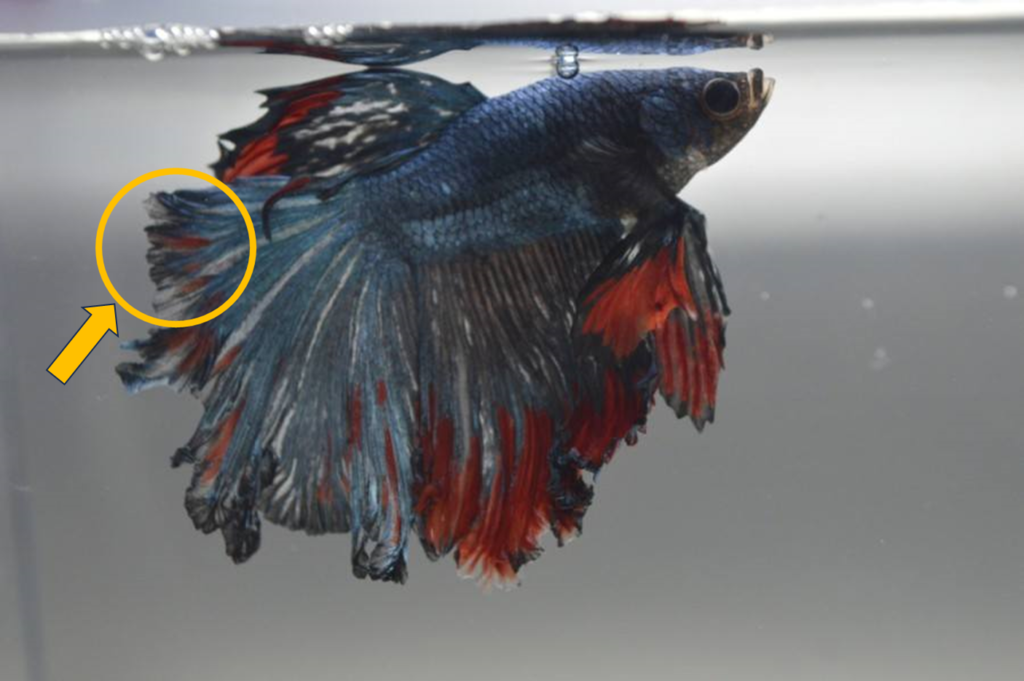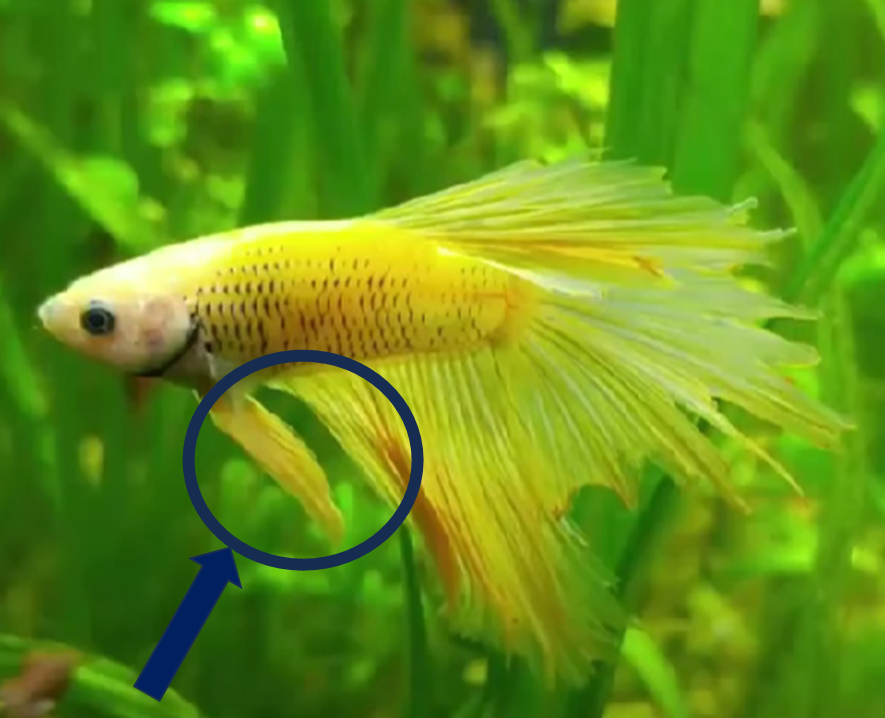In this educational voyage through “Betta Fish Health 101,” we unravel two common yet distinct adversaries: betta fin rot vs fin loss. Embarking on the fulfilling journey of Betta fish ownership entails more than vibrant tanks and graceful movements. As caretakers, it’s paramount to dive into the depths of their well-being, understanding nuances like fin health. Fins are not merely ornamental; they signify vitality and hint at underlying health concerns that every avid Betta enthusiast should decipher.
These stealthy intruders can silently erode your fish’s majesty, sapping vigor and compromising quality of life. By equipping yourself with knowledge on these ailments, you fortify your ability to safeguard your aquatic companions from distress while fostering a harmonious aquatic haven. Open your eyes to the intricacies of Betta care beyond aesthetics – their fins whisper tales of well-being that beckon understanding and attention.
Understanding Betta Fin Rot

Fin rot is a common bacterial infection in Betta fish that primarily affects their fins and tails. It starts with the edges of the fins appearing frayed or disintegrating, progressively moving towards the body if left untreated. This condition weakens the fish, making them more susceptible to other illnesses. Recognizing fin rot early on is crucial for successful treatment and preventing severe damage to the fish.
Causes of fin rot often stem from poor water quality in the aquarium, creating a stressful environment for Betta fish. Bacterial infections, particularly those from the Aeromonas, Pseudomonas, or Vibrio species, can also lead to fin rot. To prevent this condition, Betta fish owners should prioritize regular tank cleaning schedules and maintain proper water parameters such as appropriate temperature and pH levels. Ensuring good filtration and not overfeeding are also essential factors in keeping the aquarium environment healthy for Betta fish.
Preventive measures play a significant role in safeguarding Betta fish against fin rot. The importance of adequate tank maintenance cannot be overstated when it comes to maintaining optimal water quality. Offering a well-balanced diet rich in essential nutrients can also boost your pet’s immune system, reducing their vulnerability to diseases like fin rot. By adopting these proactive approaches, Betta fish owners can provide a conducive habitat that minimizes the risk of health issues stemming from poor water conditions or bacterial infections.
Identifying Betta Fin Rot Symptoms
When it comes to Betta fish health, identifying the symptoms of fin rot early on is crucial for effective treatment. Common signs of fin rot in Betta fish include fins that appear frayed, discolored, or disintegrating. As this bacterial infection progresses, the fins may continue to erode, leading to a deteriorated appearance.
Early detection plays a vital role in addressing fin rot successfully. Betta fish owners need to pay close attention to any changes in their fish’s fins and behavior. If left untreated, fin rot can advance rapidly and cause significant damage not only to the fins but also potentially compromising the overall health of the fish.
To help Betta fish owners recognize signs of fin rot promptly, visual examples can be incredibly helpful. By providing images or illustrations showing healthy fins compared to those affected by fin rot, individuals can better understand what to look for when assessing their own pets. This visual aid aids in distinguishing between normal wear and tear versus the more concerning symptoms associated with fin rot.
Treating Betta Fin Rot
Treating fin rot in Betta fish involves a combination of medication and improving their habitat conditions. Antibacterial medications specifically designed for treating fin rot can help combat the bacterial infection causing the disease. These medications are commonly available in pet stores or can be prescribed by a vet. It’s crucial to follow the instructions carefully when administering these medications to ensure their effectiveness in combating the infection.
In cases where the fin rot is severe or doesn’t improve with over-the-counter medications, consulting a vet specialized in aquatic pets is highly recommended. Vets can provide expert guidance on tailored treatment plans suited to the individual fish’s condition. They may recommend stronger antibiotics or alternative treatments based on a thorough examination of the Betta fish.
To administer treatment at home successfully, it’s important to maintain pristine water quality in the Betta fish tank. Regular water changes, ensuring appropriate filtration, and monitoring ammonia levels are essential steps in aiding the fish’s recovery from fin rot. Additionally, providing a stress-free environment by avoiding sudden changes in water parameters and maintaining consistent temperatures can support the healing process. By following a comprehensive treatment plan and creating optimal living conditions, Betta fish owners can effectively combat fin rot and promote their pet’s overall well-being.
Exploring Betta Fin Loss

Fin loss refers to the physical condition where Betta fish experience the partial or complete loss of their fins. Unlike fin rot, which is primarily caused by bacteria, fin loss can result from various factors such as aggression from tank mates or injuries sustained during tank decorations. Understanding the distinction between fin loss and fin rot is crucial for implementing appropriate treatment strategies and ensuring the overall well-being of Betta fish.
Aggressive behavior from other tank inhabitants, particularly in community aquarium setups, can lead to stress-induced fin nipping in Betta fish. Inadequate space within the aquarium or incompatible tank mates with territorial tendencies can exacerbate this issue. Likewise, physical injuries caused by sharp edges in decorations or improper handling during maintenance can also result in fin loss. By taking proactive measures to minimize potential stressors and hazards within the aquarium environment, pet owners can significantly reduce the risk of bettas losing their fins.
To prevent bettas from experiencing excessive stress that may ultimately lead to fin loss, aquarists should carefully select compatible tank mates and provide adequate hiding spots for each fish to retreat to when needed. Additionally, maintaining a harmonious aquatic community through proper feeding routines and monitoring interactions among different species can help mitigate aggressive behaviors that contribute to fin loss. Regularly inspecting tank decorations for any sharp edges that could potentially harm bettas’ delicate fins is essential in creating a safe habitat conducive to their health and well-being.
Identifying Betta Fin Loss Symptoms
Betta fin loss can manifest in various forms, from ragged edges to sudden disappearance of entire fins. One key symptom to look out for is white edges or tips on the fins, indicating potential fin rot. Additionally, if you notice your betta fish becoming lethargic or losing its vibrant colors along with fin deterioration, it may be a sign of underlying health issues. Monitoring water quality and ensuring a well-balanced diet are crucial in preventing and addressing betta fin loss.
Moreover, environmental factors such as poor water conditions or aggressive tank mates can also contribute to fin loss in bettas. It’s essential to observe your fish closely and take prompt action if you notice any concerning symptoms. Engaging in regular water changes and maintaining proper filtration can significantly reduce the risk of fin loss due to bacterial infections or stress. By staying vigilant and providing a healthy environment for your betta fish, you can help them thrive and maintain their beautiful fins for years to come.
Treating Betta Fin Loss
Treating fin loss in betta fish can be a challenging task, requiring patience and the right approach. While fin loss is often a result of poor water quality or aggressive tankmates, it’s crucial to address the underlying cause to promote healing. One effective method is maintaining pristine water conditions by performing regular water changes and testing the water parameters regularly.
Additionally, providing a balanced diet rich in protein can help support fin regrowth and overall health. Some betta fish owners also swear by adding Indian almond leaves to their tanks, as they possess anti-inflammatory properties that can aid in healing fins. It’s essential to create a stress-free environment for your betta fish as stress can exacerbate fin loss. By following these tips and staying consistent with treatment, you can help your betta fish recover from fin loss and thrive once again.
What is the Differentiating Between Betta Fin Rot Vs Fin Loss ?
When it comes to distinguishing between fin loss and fin rot in betta fish, understanding the key differences in symptoms is crucial. Fin rot typically presents as frayed or disintegrating fins, often with discoloration or white edges indicative of a bacterial infection. On the other hand, fin loss involves the actual disappearance of sections of the fin due to physical trauma or stress. The texture and appearance of the fins can offer valuable clues in determining which condition is affecting your betta.
Misidentifying fin loss as fin rot can lead to inappropriate treatment methods being applied, potentially worsening the situation for your betta fish. For example, using antibacterial medications for fin loss caused by aggressive tank mates will not address the underlying issue and may even harm your fish. By accurately recognizing whether your betta is experiencing fin rot or simply losing fins due to external factors, you can provide targeted care that addresses the root cause effectively.
To aid readers in distinguishing between these two health issues accurately, consider this scenario: If your betta’s fins appear ragged with a white edge and signs of deterioration, it might indicate fin rot necessitating antibacterial treatment. Conversely, if you notice chunks missing from the fins following an altercation with another aggressive fish in the tank, it is likely a case of fin loss due to physical damage rather than bacterial infection. By closely observing and interpreting these visual cues, you can confidently differentiate between fin rot and fin loss in your bettas for appropriate intervention strategies.
Promoting Fish Health & Well-being
Maintaining a healthy environment is paramount in safeguarding Betta fish against common ailments like fin rot and fin loss. Adequate tank hygiene, proper water conditions, and suitable decor are vital to a betta’s well-being. Regularly cleaning the tank, monitoring water parameters, and utilizing filtration systems can help prevent stressors that contribute to these health issues.
Bettas require a diet rich in protein and nutrients to support their vibrant colors, energy levels, and most importantly, strong fins. High-quality pellets or frozen foods tailored for bettas should constitute their primary diet. Ensuring variety in the diet with live or frozen treats such as bloodworms or brine shrimp can enhance their overall health and fortify their fins against potential diseases.
Encouraging routine observation practices among betta fish owners is crucial for early detection of any signs of distress or illness. Observing changes in behavior, appetite, or physical appearance can alert owners to underlying health concerns. By promptly addressing these red flags through proper diagnosis and treatment, pet enthusiasts can effectively mitigate the risks associated with fin rot and fin loss, promoting the longevity and vitality of their beloved aquatic companions. You can also check our article “10 Best Betta Fish Water Conditioner You should consider“.
Conclusion
Understanding the difference between betta fin rot vs fin loss is vital for the well-being of Betta fish. By recognizing the specific symptoms and causes of each condition, owners can provide prompt and appropriate care to their aquatic pets. Throughout this article, we have discussed the importance of maintaining clean water conditions, identifying early signs of disease, and seeking professional help when needed to ensure the health of Betta fish.
Proactive tank maintenance, attentive monitoring for any changes in behavior or appearance, and a balanced diet are crucial elements in preventing both fin rot and fin loss in Betta fish. Remember, a healthy environment promotes strong fins and overall wellness for your cherished aquatic companions. By staying informed and taking preventive measures, Betta fish owners can enjoy thriving pets with vibrant fins for years to come.

I’m John S, and I’m thrilled to share my passion for fishkeeping with you. With over 15 years of experience under my belt, I’ve swum through the highs and lows of aquarium maintenance, and I’m here to make your aquatic journey as smooth as possible.